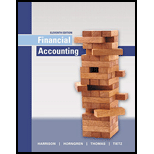
To identify: The appropriate debit/credit entry for the issuance of common stock from the given options.
Answer to Problem 1QC
c. credit to common stock for $30,000
Explanation of Solution
Common stock: These are the ordinary shares that a corporation issues to the investors in order to raise funds. In return, the investors receive a share of profit from the profits earned by the corporation in the form of dividend.
Par value: It refers to the value of a stock that is stated by the corporation’s charter. It is also known as face value of a stock.
| Date | Account Titles and Explanation | Debit ($) | Credit ($) |
| Cash (1) | 330,000 | ||
| Common Stock (2) | 30,000 | ||
| Paid-in Capital in Excess of Par value –Common stock (3) | 300,000 | ||
| (To record issuance stock for cash) |
Table (1)
Working note:
Compute the amount of cash received.
Compute common stock value.
Compute paid-in capital in excess of par-common value.
- Cash is an asset account. The amount has increased because cash is received by issuing shares; therefore, debit Cash account with $330,000.
- Common Stock is a
stockholders’ equity account and the amount has increased due to issuance of common stock. Therefore, credit Common Stock account with $30,000. - Paid–in Capital in Excess of Par–Common is a stockholders’ equity account and the amount has increased due to increase in capital. Therefore, credit Paid–in Capital in Excess of Par–Common account with $330,000.
Option a:
“Option a” is not correct, because issuance of stock debits cash account but not common stock account.
Option b:
“Option b” is not correct, because credit amount of paid-in capital in excess of par must be $300,000 but not $330,000.
Option c:
“Option c” is correct, issuance of common stock credits common stock account for $30,000.
Option d:
“Option d” is not correct, because option a is not correct, even if option b is correct.
Want to see more full solutions like this?
Chapter 10 Solutions
Financial Accounting Plus MyLab Accounting with Pearson eText - Access Card Package (11th Edition)
- E4-8 Plevin Company ended its fiscal year on July 31, 2014. The company's adjusted trial balance as of the end of its fiscal year is shown below. PLEVIN COMPANY Adjusted Trial Balance July 31, 2014 (b) Tota Journal entries, closing (LO 2, No. Account Titles Debit Credit 101 Cash $ 9,840 112 Accounts Receivable 8,780 157 Equipment 15,900 158 Accumulated Depreciation-Equip. $ 7,400 201 Accounts Payable 4,220 208 Unearned Rent Revenue 1,800 301 Owner's Capital 45,200 306 Owner's Drawings 16,000 400 Service Revenue 64,000 6,500 429 Rent Revenue 711 Depreciation Expense 8,000 726 Salaries and Wages Expense 55,700 732 Utilities Expense 14,900 $129,120 $129,120 Instructions (a) Prepare the closing entries using page J15. (b) Post to Owner's Capital and No. 350 Income Summary accounts. (Use the three-column form.) (c) Prepare a post-closing trial balance at July 31.arrow_forwardGeneral accounting questionarrow_forwardI am searching for the correct answer to this general accounting problem with proper accounting rules.arrow_forward

 AccountingAccountingISBN:9781337272094Author:WARREN, Carl S., Reeve, James M., Duchac, Jonathan E.Publisher:Cengage Learning,
AccountingAccountingISBN:9781337272094Author:WARREN, Carl S., Reeve, James M., Duchac, Jonathan E.Publisher:Cengage Learning, Accounting Information SystemsAccountingISBN:9781337619202Author:Hall, James A.Publisher:Cengage Learning,
Accounting Information SystemsAccountingISBN:9781337619202Author:Hall, James A.Publisher:Cengage Learning, Horngren's Cost Accounting: A Managerial Emphasis...AccountingISBN:9780134475585Author:Srikant M. Datar, Madhav V. RajanPublisher:PEARSON
Horngren's Cost Accounting: A Managerial Emphasis...AccountingISBN:9780134475585Author:Srikant M. Datar, Madhav V. RajanPublisher:PEARSON Intermediate AccountingAccountingISBN:9781259722660Author:J. David Spiceland, Mark W. Nelson, Wayne M ThomasPublisher:McGraw-Hill Education
Intermediate AccountingAccountingISBN:9781259722660Author:J. David Spiceland, Mark W. Nelson, Wayne M ThomasPublisher:McGraw-Hill Education Financial and Managerial AccountingAccountingISBN:9781259726705Author:John J Wild, Ken W. Shaw, Barbara Chiappetta Fundamental Accounting PrinciplesPublisher:McGraw-Hill Education
Financial and Managerial AccountingAccountingISBN:9781259726705Author:John J Wild, Ken W. Shaw, Barbara Chiappetta Fundamental Accounting PrinciplesPublisher:McGraw-Hill Education





